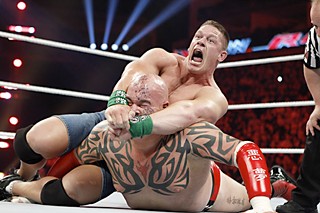You Got Your Interwebs in My Idiot Tube
Studying WWE's playbook for social TV domination
By Richard Whittaker, Fri., March 8, 2013

Once, broadcasters grappled with the menace of smartphones and the Internet, and feared they would be down for the count. Now, they are reversing digital media's stranglehold and forming an unstoppable tag team. Against the expectations of many, it's World Wrestling Entertainment – home to pro wrestlers like The Rock and John Cena – that holds the gold.
Last August, Perkins Miller joined the WWE as its executive vice president of digital media. Previously head of NBC's digital operations for the 2008 and 2010 Olympics and COO of Universal Sports Network, he saw a unique opportunity with the WWE. He said, "We have, in our fans, a group of people who are so hungry to tie into our storylines and engage with our program. It's something I'd never seen before." The WWE obsessively tracks and curates that fan base: When Miller came on board, the company had 110 million followers and subscribers across all the social media it tracks; that number has since climbed to 138 million. Those fans are not passive, and Miller has the numbers to prove it. The WWE holds its annual Slammy Awards during its flagship show, Monday Night Raw. Last December, fans cast nearly a million votes via the WWE's app during the three-hour broadcast. Miller said, "I think we've pretty much set the standard for a show-driven second-screen experience."
Sometimes it's up to media scions to innovate. Just as the porn industry spearheaded secure online payment, the WWE adopted pay-per-view technology in 1985. In 2006, the firm took a radical step forward for its Cyber Sunday event: Viewers could select contestants and matches by voting online at WWE.com. The technology was clunky, but the vision was there. Seven years later, voting for matches on Raw is commonplace, either through Twitter hashtag tracking or, more recently, through the WWE's own app. The firm even has its own social media platform: In 2012, it invested $5 million in Tout – the video equivalent of Twitter – where users can upload 15-second video clips, and those clips are integrated into WWE programming.
The WWE is far from alone in adopting a second-screen approach – but it has been more successful than most. In 2011, it dominated the Mashable Awards, including winning Digital Company of the Year and Must-Follow Brand on Social Media. That didn't come from embedding a few videos on the website. During TV shows, a Tweet ticker, gathering performer and fan Tweets, runs across the bottom of the screen, while the commentators track trending WWE-related hashtags. Its YouTube channel, with over a million subscribers and almost half a billion views, has its own dedicated behind-the-scenes shows. Through them, established stars build their brands, and new wrestlers become household names before they ever see TV time. Now the WWE wants to focus all that fan energy through its app. Miller said, "The first thing I challenged our team to do was to transfer the app into a live second-screen experience for our fans. That meant putting a crew backstage live, to stream 10 or 11 segments of live programming in a second-screen environment, in your home, and then to integrate all our social feeds into that experience."
After all, the WWE is a live experience, putting on two TV recordings and multiple untelevised "house shows" every week, as well as monthly PPVs. Before every live event, Miller and his team prepare "Tweetsheets" containing social media cues for the entire team. He said, "We make sure that, when the writers are working on the storyline, the talent are engaged and know where the social connections are engaged. We work with them on getting them to Tout, work with them on their tweeting, work with them on their social messaging outside of the venue."
Jason Hoch was Miller's predecessor at WWE: Now a senior vice president at social media strategists and app developers Echo, he argues that media brands are wisely responding to "that new need that says, 'I want it now, and I want it 24 hours a day, seven days a week.'" He sees the smart ones reorganizing their whole company. When he was at WWE, he said, "The approach was not that there was just a social media department, but every piece of that business, right from the top to the creative teams to the live events staff to the writers to the superstars themselves, now have a stake in telling that story for the fans that really expect it on a 24/7 basis."
So how has the WWE adapted so fast to the second-screen experience? Miller argues that the firm has always been an early adopter, from PPVs to cable: Hoch goes back further, to the old pro wrestling rule of "kayfabe." Back before TV shows, when the industry was still run by regional promoters, no one admitted that matches were predetermined, no one talked about what happened behind the curtain, and if your wrestling persona – or gimmick – was that you were a bone-breaking fiend, then you would never be seen kissing babies. Wrestlers, promoters, referees, and even the audience were all in on it. The 24/7 media environment just continues kayfabe. Hoch said, "The reason social media fits so well is that it's an extension of that storytelling experience that they've never had before."
Generally, it has been sports and newscasters making best use of second screens: ESPN ties their apps heavily into their TV content, and vice versa, and Turner Broadcasting acquired sports news website Bleacher Report last August. For Echo CEO Khris Loux, it's no surprise they have been such vehement earlier adopters, since he traces what he calls "this compression of time" in TV back to when CNN started doing real-time news. Blogging and Twitter accelerated that process, but it also made the reporting process much more of a two-way street with audiences. He said, "It is essentially impossible for CNN to fly someone to a given news hot spot in the world faster than someone who is right there tweeting about it."
However, narrative shows are getting stronger on their web presence. Jenn Deering Davis, co-founder of Union Metrics and a former doctoral fellow at UT Austin, cites ABC Family's Pretty Little Liars as "a great example" of second-screen engagement. She said, "They tweet during the show, post as characters onscreen, play games, reveal behind-the-scenes information." The combination has meant a huge Twitter following, she said, "And their ratings are terrific. Their fan base is deeply engaged on social media and it keeps them watching."
Deering Davis suggests that, when established media brands launch a second-screen push, the campaign "is focused on reaching current fans and getting them more deeply engaged and invested in the show." However, a well-timed social media strategy can make or break a new show. The only problem for broadcasters is that they are never in control: Like Nielsen ratings, that's up to the audience. While Netflix used its own Twitter feed to promote its original political drama House of Cards, Deering Davis said, "The reason I decided to actually watch was because it felt like everyone I follow on Twitter watched it and loved it. ... My community has vetted the show for me, and I'll take their endorsements as social proof to start watching myself."
Loux warns that content providers shouldn't just try to replicate the WWE's social media strategy, but need to find what works for them and their audience. For him, the various social media platforms are "LEGO blocks you can put together in many, many different ways." The real key lies in breaking down the office walls between the TV operation and the Web office. As time goes on, he said, "The social group, content creation, and engineering will form one group, and you will not be able to distinguish them." That way, he said, "When I'm creating content, I'm already creating social."
Related Events
How Twitter Has Changed How We Watch TV
Saturday, March 9, 9:30am
ACC, Room 18ABCD
Get Ready to Rumble! How WWE Is Crushing Social TV
Saturday, March 9, 11am
Sheraton Austin, Capitol EFGH
Death of the Couch Potato: The Future of Social TV
Sunday, March 10, 5pm
ACC, Room 18ABCD











